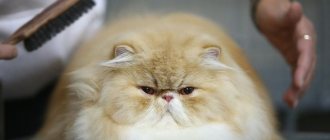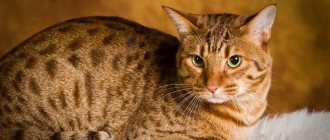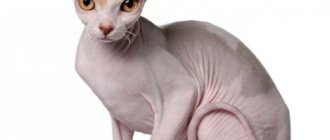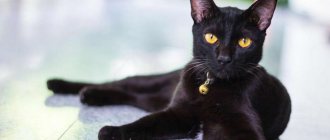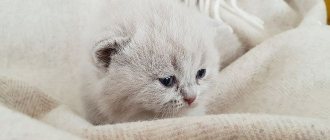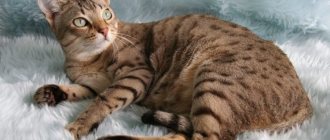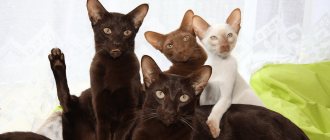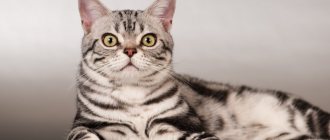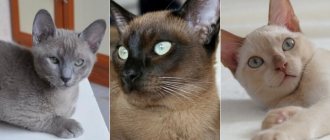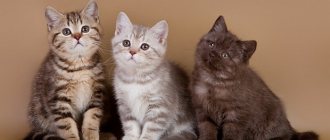Origin story
The Persian chinchilla is a real aristocratic cat.
Graceful features, dignity in every movement, flexible character, rare color - all this makes the breed extremely popular. And not only in the place where the first representatives of Persian chinchillas appeared - in Britain. The story goes that the first Persian chinchilla was born in 1882. Her stuffed animal is still kept in the Natural History Museum under the name “silver lambkin”. Keeping such a breed at home was considered prestigious, so many members of the elite (including relatives of Queen Victoria) lived with these individuals.
If you dig deeper into the history of the appearance of Persian cats in Europe, the following version looks plausible: they were brought from Iran in the 16th century, and having multiplied, they gave birth to a new breed with a wonderful color. The modern name for the breed was assigned in the 20th century, at which time breeders from different countries began to work with the breed. But it is worth noting that the adjustment was minimal.
Types of colors
These cats have dark black fur, undercoat, and usually have orange eyes.
Color point
Points of all shades are possible, with the obligatory presence of cream or ivory. Blue eyes.
White
Pure white coat color. The eyes are usually blue or orange, but other shades are also found.
It has lilac, chocolate, smoky with different shades, blue, black shades, blue, black shades.
The undercoat is silvery.
The color consists of evenly spaced spots of cream, blue, black and chocolate. The boundaries of the spots are not defined. Copper eyes.
The rich red color is uniform throughout the coat. Eyes the color of fur.
Standards
This breed is classified as large, since males are able to gain up to 7-8 kg of weight. Females weigh much more modestly: no more than 4.5 kg. Kittens aged 1.5-2 months weigh 600 grams.
| Standard | Description |
| Head | Oval, medium size. The muzzle is round, with expressive features. The forehead, chin and nose are located almost on the same line. |
| Nose | Flat. "Stop" is clear. |
| Eyes | Almond-shaped, large, widely spaced. Iris color: all shades of green. The outline of the eyes is outlined in black, as are the lips. |
| Ears | Small, neatly and widely spaced. Small tassels are visible at the tips. |
| Tail | Short, thick, curvy. The fur on it is 18-20 mm longer than on the rest of the body. |
| Torso | Strong, muscular, elongated. The back is straight. The back is rounded. |
| Limbs | Powerful, but appear short due to the abundance of hair. The paws are round, elastic, the pads are pink, but a dark color is also allowed. |
| Wool | Thick, pleasant to the touch, with a characteristic shine. |
Breeders, in an attempt to improve the breed, crossed Persian chinchillas with British and Persian cats with smoky colors and turquoise eyes. However, the offspring's eye color changed to yellow, which the breeders categorically did not like. Therefore, it was decided that it was best to use exclusively Persian blood.
Kittens
The Persian breed is most active in childhood. He enthusiastically explores the apartment, attacks a fly hiding on the wallpaper, or disappears into the wilds of the country lawn, revealing ancient instincts. Early returns may be susceptible to food allergies, so try to introduce them to quality dry food.
How long do Persian cats live? Pets may be susceptible to skull deformation, eye diseases, and have breathing problems
. But one way or another, the average life expectancy is 14-15 years. There is an opinion that male Persians are more active and aggressive, while females are docile and gentle. But in reality this is far from the case. It is the female Persians who show greater independence and autonomy. You should take this fact into account when purchasing a pet.
Interesting!
The average cost of a Persian cat in the world is from 300 to 800 US dollars.
Colors
The classic Persian chinchilla has snow-white fur. But there is also a so-called veiled color: when the tips of the hairs are colored and give the coat a certain shade. There may be several of them:
- Black.
- Tortoiseshell (this color is found only in cats).
- Lilac.
- Silver.
- Yellow (or rich apricot).
- Chocolate.
- Striped.
- Smoky.
There are animals with golden tips - the Persian golden chinchilla, as well as the red cameo and cream cameo - the tips are colored cream and red, respectively.
The photo shows a cat of the Persian chinchilla breed. Classic white color, as well as silver and gold
Classic-colored cats have the most pigment in the ears, tail and paws. It has also been noted that the shorter the coat, the brighter the color. Golden chinchillas have a creamy, reddish or milky undercoat, and the hairs at the tips are brown. All together creates a feeling of shimmer on the wool.
Types of Persian cats
Persian cats were domesticated several centuries ago, and since then their appearance has undergone many changes. Thanks to breeders, today there are several types of this breed.
Depending on the color, there are about 100 varieties. Cats can have a single color, or they can consist of several colors and shades.
The most noticeable distinguishing feature in the description of a Persian cat is its nose. It is small, wide and snub-nosed. There are several types of Persian noses. Depending on its type, there are several types of Persian cats:
- Classic British - straight nose, located just below eye level
- European - snub nose, the upper edge of which is at the same level as the lower eyelids
- Extreme - snub nose, which is located on the same level with the upper eyelid.
Previously, there was another type of Persian cat - peakface. Their nose was located above the level of the upper eyelid. Their breeding was prohibited due to significant health problems
These cats have: breathing problems, constant lacrimation, malocclusion, problems eating. Such cats lived very rarely. The extreme type of Persians is the result of selection taking into account the rules of humane treatment of animals.
Character and behavior
Persian chinchillas are real phlegmatic people: calm, measured, imperturbable, but sociable and friendly. A turbulent life with endless bustle and the search for adventure is alien to representatives of this breed. The sweetest thing for them is to find themselves a cozy, warm place, on a soft sofa or windowsill, and hum a song to themselves while watching what is happening next to them.
But it is a mistake to think that little Persians are not able to play! Like any cats, “chinchillas” love to play with strings, chase a ball rolled out of paper, and hunt around the corner for a bow on their owner’s slipper.
However, all this is the innocent fun of a cute animal and will never develop into wild races throughout the apartment with overturning floor vases, hanging on curtains and scratching the owner’s furniture while meowing victoriously. “Chinchillas” rarely speak, preferring to communicate with their eyes (therefore, owners of breeding females should carefully monitor the onset of estrus themselves).
Persians get along with both adults and children. And of all ages. You can safely leave even very young children with them: Persians do not use their claws and teeth, preferring to resolve conflicts quietly and peacefully. In extreme cases, they will simply run away to some secluded place where the child cannot reach him.
What breeds do you prefer?
ShorthairLonghair
The Persians are too flexible to be the first to go into conflict, and too lazy to hunt. And it would seem that there are no obstacles to the appearance of other animals in the house. Yes, there are no obstacles, and you can easily get a couple of rodents or parrots.
But other dogs and cats make Persians nervous: large animals give them a sense of danger, small animals make them jealous. And if you get an active animal that won’t give your “chinchilla” peace, it will begin to turn into an unsociable person and may even get sick and start fighting with it! Therefore, remember: placing someone with adult Persians is fraught with a lot of problems. If your dog and cat grew up together, there will be no problems.
This does not apply to cats of the same breed. Persians get along well side by side, probably due to their 100% similarity in character. By the way, breeders recommend getting your Persian a girlfriend or boyfriend even if you are a busy person and cannot pay enough attention to your pet, or often leave home.
Persians quickly get used to their new home and easily tolerate moving and changing surroundings. Leaving them at home, you can be sure that when you return, you will not find any damage. The main thing is not to forget to leave the cat a few toys. Kittens do not need company, while adults rarely play on their own, preferring to lie in the sun and doze.
Persians are not averse to taking a walk in a park or other quiet place where grass grows. Therefore, immediately accustom your kitten to a harness.
These cats are touchy and very sensitive. Do not raise your voice at them, even if they do something wrong, otherwise they will get scared and stop trusting you.
Persian chinchillas are not the most expensive breed, but the cost depends on the pedigree, litter and other factors. The average cost of a kitten is 20,000 rubles.
Attachment to family
Persian chinchillas are known for being calm, intelligent and affectionate creatures that can form strong bonds with their owner and other members of their family. When the apartment's inhabitants come home, the fluffy purr greets them joyfully and immediately begins to demand attention - he climbs up on his arms, rubs himself on his legs, and follows people on their heels from room to room. Being on the street can be disastrous for her. However, together with the owner, the cat will feel comfortable in any environment. Most Persians are docile and will not try to run away during a walk. He has a very flexible and kind character. The Persian chinchilla is loving and cannot do without your affection. The gullibility of these cats puts their owners into a state of endless tenderness; they go into the arms of even complete strangers. They get along great with children and pets. They prefer to spend more time on their laps and next to their owner. Despite their gentle nature, they have rather predatory habits and do not miss a moment to hunt for mice, while showing maximum accuracy and intelligence. As mothers, Persian chinchillas are very protective of their kittens, caring for them and teaching them the most necessary skills. Kittens of this breed lead an active lifestyle, play with pleasure, but at the same time remain quite tolerant of loneliness; being alone for a long time, they do not cause any trouble to their owners.
Persian chinchilla
Care instructions
There are a lot of difficulties in caring for Persian chinchillas.
Wool
The main attention, of course, is paid to their coat. Beautiful, shiny and long fur quickly turns into a matted dull “something” without proper care. Therefore, you will have to comb your cat every day, using both a slicker brush and a special wide-tooth comb. The process begins with the tummy, chest and hind legs, then the head, back, hindquarters and tail are processed: in the direction of hair growth first, then against the growth.
Bathing
You need to bathe your animal either when it gets dirty or once every 2-3 months. Human shampoos and gels are not suitable: after licking off the remains, the cat will develop severe intestinal upset. Therefore, purchase the necessary products at the pet store - “Detangling Celandine”.
If your dog is categorically against bathing, is overly nervous and worried, reduce the number of baths to a minimum and, if possible, use dry shampoo, and wipe particularly dirty areas with wet wipes.
Animals that participate in exhibitions require special care. Tinted detergents allow you to give its appearance a special shine and will not allow a light fur coat to turn yellow.
Eyes
The Persian's eyes also require constant monitoring. The flattened muzzle of the Persian leads to the fact that the animal from an early age begins to suffer from constant lacrimation (the eye canal is poorly formed). There is a high risk that pathogenic bacteria will get into the eyes and inflammatory processes will begin.
Therefore, wash your cat’s eyes with special eye drops (you can use warm, freshly brewed chamomile infusion or saline solution) and a cotton swab.
Ears
The ears are wiped with a damp cotton sponge once a week. Nails are trimmed with the same frequency. True, many Persians know how to sharpen them on their own, and they do not need your help. Teeth are brushed once every 2 weeks with a special toothbrush and cat paste. Once a year it is worth paying for ultrasonic tartar removal.
It is best to clean the cat's litter box immediately after the cat has gone to the toilet. Filler – silica gel or wood shavings. Once a month, pour boiling water over the tray.
In the photo there is a cat of the Persian chinchilla breed
How to behave with chinchillas?
To keep a chinchilla cat, the owner should be patient, because the long coat needs daily care. It may form tangles or lumps that are difficult to comb out. To prevent this from happening, the cat needs to be combed first along the growth of the fur, and then in the opposite direction. This is the only way to achieve high-quality combing of two-level wool.
To keep the coat white, you need to use a shampoo with a whitening effect. This is a good way to avoid yellowing.
There is another problem: the Persian chinchilla often “cries” - tears often flow from its eyes due to poor formation of the tear duct. In this regard, you need to ensure that no infection gets into your eyes; to do this, you should frequently rinse your eyes with special solutions. The condition of the eyes must be monitored especially carefully, because this breed has a tendency to develop retinal diseases.
So, the basic rules for keeping the Royal Persian Angora, as this breed is called, are as follows:
- Daily brushing.
- Eye hygiene (fighting tearfulness).
- Bathing with whitening shampoo.
- High quality food.
You can go for walks with a Persian chinchilla, cats welcome it. It is better to keep the animal on a harness at this moment.
Catering
The tendency towards obesity and kidney pathologies suggests that the menu for your pet should be prepared with special care. If you feed him too much fatty food or too much protein, he will become lazy and quickly gain weight. And this is a direct path to disease.
You can feed the Persian chinchilla both natural and commercial food. But for each type there are certain rules that you should follow.
Natural products
The following foods can be included in the Persian diet:
- Lean meat: veal, beef, poultry (chicken, turkey), rabbit. Before serving, the meat is doused with boiling water to destroy parasite eggs.
- Offal: raw chicken hearts, boiled liver, finely chopped necks.
- Sea fish, shrimp, squid.
- Eggs: chicken and quail. Quail can be given raw, chicken is boiled and only the yolk is given.
- Fermented milk products: cottage cheese, sour cream, natural yogurt without preservatives and dyes, cream, fermented baked milk, kefir, unsalted cheese.
- Cereals: buckwheat, oatmeal, millet, rice. Porridge is boiled in water, a little milk is added for taste. Liquid semolina porridge is fed to kittens up to 3 months.
- Vegetables: pumpkin, carrots, zucchini, asparagus, herbs (dill, parsley, green salad), cucumbers.
- Sprouted wheat.
The cat's bowl should always be filled with clean water at a comfortable temperature. Bottled or settled - it doesn’t matter, but pouring from the tap is not recommended. Change it twice a day: morning and evening.
It is forbidden to give cats:
- Alcohol, sparkling water, juices, coffee, tea.
- Avocado, eggplant, grapes.
- Dried fruits.
- Peas, chickpeas, lentils.
- Sausage, wieners, frankfurters.
- Offal, bones, fat, lard.
- Whole milk.
- Sweets, baked goods, flour, fried.
- Smoked, salted, fatty.
- Human canned food.
- Spices, sauces, mayonnaise, seasonings.
Expert opinion
Dusheba Vera Ivanovna
In 2010, she graduated from the Moscow State Academy of Veterinary Medicine named after K.I. Scriabin with honors, specializing in veterinary medicine. I regularly attend veterinary conferences, congresses, and webinars.
Since Persians are prone to urolithiasis, you should not pamper your cat with fish more than once a month.
Recommended food
Industrial food (both dry and wet) can save a lot of time if you don’t like or can’t prepare your cat’s food yourself. Modern holistic and super-premium foods have a balanced composition and a sufficient amount of vitamins and microelements necessary for the development of a cat.
In the photo there are kittens of the Persian chinchilla breed
List of holistic foods: Farmina N&D, Gather, Power of Nature.
Expert opinion
Dusheba Vera Ivanovna
In 2010, she graduated from the Moscow State Academy of Veterinary Medicine named after K.I. Scriabin with honors, specializing in veterinary medicine. I regularly attend veterinary conferences, congresses, and webinars.
Forget about economy-class food: they contain practically no useful additives or meat. And without these components, the product turns into empty “chewing gum.” In addition, they often cause allergies.
Super premium food: Airi, Arden Grange, Naturea, Pronature Life.
Below are recommended super-premium foods. Links with the names of the food are clickable, on them you can, within our website, get acquainted with the descriptions of the food and read reviews from owners of Persian chinchilla cats.
| Super Premium | Super Premium | Holistic |
| Meowing Heads | Leonardo | PureLuxe |
How long do Persian cats live?
So, how many years do Persian cats live? The average lifespan of these animals is 8-13 years.
This is due to the fact that, due to their external characteristics, Persians seriously suffer from diseases of the respiratory system.
Their flattened nose does not provide the proper amount of oxygen to the lungs.
This is not fatal, but throughout life, oxygen deficiency becomes more acute, organs “wear out” faster, metabolism and the speed of blood movement through the vessels slow down.
Because of such a cute and exotic breed feature, the lungs suffer. Persians often have secondary lobar pneumonia, emphysema, bronchitis, as well as a disease called atelectasis (collapse of the lungs or alveoli in them).
When the lungs are affected, the already small amount of oxygen entering the body is reduced. This threatens to disrupt the functioning of the heart, hematopoietic and nervous apparatus.
The blood carries less oxygen, becomes denser, and the heart has to contract more often to ensure the necessary blood flow. Against the background of these symptoms, the following may develop: tachycardia, myocarditis, acquired heart disease, fibrillation, and other types of cardiac arrhythmias.
It is much easier to cure most diseases in the initial stages than later, when the symptoms become more acute or the disease becomes chronic.
Sterilization, as well as proper rational feeding throughout life, greatly prolongs the life of a cat.
Diseases
Following basic hygiene rules will reduce the risk of your pet contracting some dangerous diseases. When you come from the street, wash your hands immediately. Do not approach the cat in outerwear. The same applies to shoes: they can easily bring pathogens from the street. First of all, this applies to cats that have not yet been vaccinated.
A peculiarity of Persians is snoring during sleep. This is a feature of the body associated with congenital deformation of the nasal septum, so do not panic.
- Eye infections occur frequently in Persians. The treatment method is chosen by the veterinarian: in some cases medication is sufficient, in others only surgery will help.
- Polycystic kidney disease is the formation of cysts on the organ. Causes kidney failure. Maintenance therapy is recommended.
- Gingivitis and periodontitis are also quite common. If the disease is advanced, only tooth extraction will help.
- The special structure of the nasal passages leads to frequent colds. The cat should be protected from hypothermia: do not allow it to sit in a draft, dry its fur with a hairdryer after bathing, do not feed food from the refrigerator, and do not walk in bad weather.
- Hypertrophic cardiomyopathy is a thickening of the heart muscle. The cat begins to get tired quickly, cough, breathe heavily and moves little. It is impossible to cure the disease, but drug maintenance therapy can significantly alleviate the condition and prolong life.
- Dermatitis is characterized by the appearance of brown discharge around the nose and eyes. The hair in these areas falls out, the skin turns red and swells, which is why the cat experiences discomfort and constantly tries to scratch this area. It often spreads to the ears. Occurs mainly in young animals. Medicines can achieve remission, but without proper control the disease develops again.
Average life expectancy of a Persian cat
Persian cats can have different life expectancies. This is influenced by the following factors: congenital and acquired diseases, attitude to a certain subspecies of the breed, proper care. On average, Persians live up to 15-20 years
.
Representatives of the classical and European species of Persians can live up to 20 years. This is possible in the absence of congenital diseases, and in the presence of a very attentive attitude on the part of the owners and regular visits to the veterinarian.
Extreme Persian cats, even with good care, live on average no more than 15 years. This is due to the structure of their muzzle, which significantly affects their health, especially at the age of more than 10 years.
Persians of any species live longer if they are spayed or neutered at an early age. These procedures prevent the occurrence of diseases that are associated with hormones.
Among the animals of this breed there are practically no long-livers - cats that live more than 20 years.
Content Features
Chinchillas, like other long-haired cats, require increased attention to caring for their coat. To prevent long hairs from tangling, the animal must be combed daily with special brushes. This procedure will not only prevent the formation of tangles, but will also eliminate unnecessary cleaning in the apartment.
No one likes it if there are hairballs lying around everywhere. With proper care, the chinchilla's hair will remain soft, silky and beautiful. If the owner nevertheless overlooks the appearance of the tangle, the ball of matted fur must be carefully cut off with scissors, being careful not to damage the animal’s skin.
Even if the cat doesn’t go for walks, fleas can still get into the apartment from the entrance and attack the animal. In this case, it is recommended to apply special drops to his withers, use an anti-flea collar, or wash the pet with a special shampoo. The litter and those places where the cat likes to lie will also require treatment. For this purpose, appropriate sprays or ampoules with insecticide are purchased to prepare an aqueous solution.
Due to a congenital defect of the nasal septum, which is a feature of the breed, chinchilla Persians often snore in their sleep. This should not frighten the owner, as it is a variant of the norm. You can walk cats in your arms or by letting them go on the grass near you. Due to their stress-resistant nature, chinchillas do not run away, do not hide, or panic in an unusual environment. As a rule, they contemplate with aristocratic restraint everything that happens around them, being in the field of view of the owner.
Unfortunately, representatives of the breed are prone to diseases of the kidneys and other internal organs, so they require regular preventive examination by a veterinarian. If you do not plan to use animals for breeding, it is better to castrate or sterilize your pet.
Such operations are not complicated, take less than an hour and are performed on an outpatient basis. The doctor can perform castration right at home. It is best to resort to this measure when the animal reaches the age of 9-10 months. We must not forget about vaccination. Even if the cat is at home all the time, the infection can be brought from the street on shoes and the animal will get sick.
Once a week, the Persian chinchilla should wipe the ears with a cotton swab, previously soaked in baby or olive oil, clearing them of accumulated wax and dirt. If the animal does not attend exhibitions, it can be cut for the summer. With such a hairstyle it will not be hot, and the short pile makes it much easier to care for.
Eye care
Chinchilla care also includes washing the eyes daily. All Persian cats have a shortened tear duct and a special structure of the skull, which is why they experience constant tearing. If the eyes are not taken care of, unsightly brown stains form under them, staining the coat . For the procedure, use gauze napkins and a choice of:
- boiled water;
- furatsilin solution;
- Black tea;
- chamomile decoction.
It is not recommended to use cotton pads or swabs to wash eyes. Cotton fibers can get on the mucous membrane and serve as an additional source of irritation. If hygiene is not carried out properly, this can lead not only to aesthetic problems, but also to eye diseases.
cat litter box
Chinchillas are just as clean as other cats. Their toilet should be kept clean by regularly changing the litter and rinsing the tray. To use for these purposes, it is best to use a plastic container sold at any pet store. The tray is selected according to the size of the animal.
